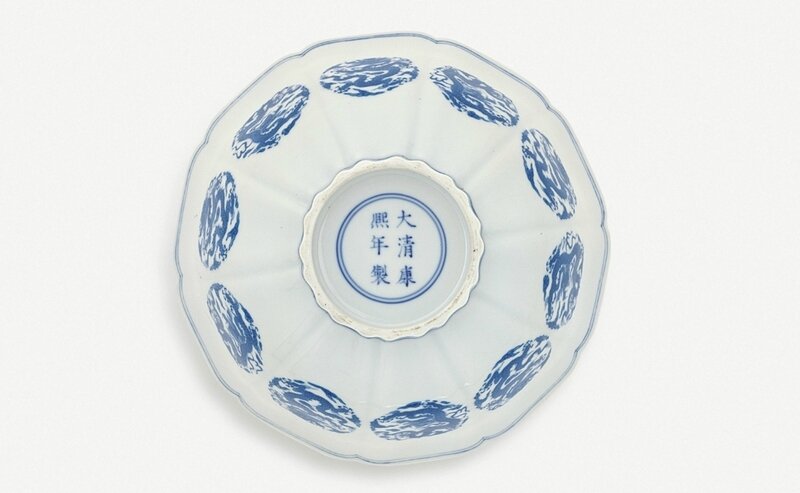A finely painted blue-and-white Ming-style bowl with dragon medallions, mark and period of Kangxi (1662-1722)
Lot 73. A finely painted blue-and-white Ming-style bowl with dragon medallions, mark and period of Kangxi (1662-1722); 19.6 cm., 7 3/4 in. Estimate 2,000,000 — 3,000,000 HKD. Lot sold 2,420,000 HKD. Photo: Sotheby's 2011.
of ten-lobed mallow shape with deep flared sides and high foot of corresponding section, the centre inside painted with a five-clawed dragon among clouds in a circular medallion, the outside with an unbordered dragon medallion in each lobe, the animals shown alternately ascending and descending, the rim and foot outlined by double-line borders, the base inscribed with the six-character reign mark in a double ring.
Provenance: Christie's London, 6th November 2007, lot 172.
Literature: Regina Krahl, Chinese Ceramics from the Meiyintang Collection, London, 1994-2010, vol. 4, no. 1709 and p. 214, fig. 16b.
Note: When the production of the imperial kilns at Jingdezhen in Jiangxi province was re-activated in the Kangxi period, after having been dormant for some sixty years, the potters began to accurately recreate designs of early Ming blue and white porcelain. The close relation of this exquisite design to the Xuande prototype, both in shape and decoration, is seen when comparing a piece formerly in the Alfred Clark collection, illustrated together with the present bowl in Krahl, op.cit., p. 214, although the present bowl omits a broad band of lotus petals above the foot, which appears on the early Ming prototype. To achieve this result, originals must have been sent down south from the imperial collection in Beijing. The present design must therefore have been specially commissioned to the Emperor's order by the Imperial Household Department in the Forbidden City.
Qing revivals of this design are otherwise extremely rare, although a similar piece from the collection of the Art Gallery of New South Wales was included in the exhibition Chinese Porcelain of the Ming and Ch'ing Dynasties, Art Gallery of New South Wales, Sydney, 1977, cat. no. 54. The Palace Museum, Beijing, owns a comparable Qing version of a Xuande mallow-shaped brush washer with similar dragon medallions, but inscribed with a spurious Xuande reign mark and attributed to the Yongzheng period, see Geng Baochang, ed., Gugong Bowuyuan cang Ming chu qinghua ci [Early Ming blue-and-white porcelain in the Palace Museum], Beijing, 2002, vol. 2, pl. 197.
Sotheby's. The Meiyintang Collection - An Important Selection of Imperial Chinese Porcelains, Hong Kong, 07 Apr 2011

/https%3A%2F%2Fprofilepics.canalblog.com%2Fprofilepics%2F1%2F0%2F100183.jpg)
/https%3A%2F%2Fstorage.canalblog.com%2F03%2F02%2F119589%2F96711876_o.jpg)
/https%3A%2F%2Fstorage.canalblog.com%2F11%2F31%2F119589%2F94773502_o.jpg)
/https%3A%2F%2Fstorage.canalblog.com%2F20%2F83%2F119589%2F94772815_o.jpg)
/https%3A%2F%2Fstorage.canalblog.com%2F26%2F72%2F119589%2F75604929_o.jpg)
/https%3A%2F%2Fstorage.canalblog.com%2F59%2F60%2F119589%2F26458628_o.jpg)





/http%3A%2F%2Fstorage.canalblog.com%2F38%2F85%2F119589%2F129124250_o.jpg)
/http%3A%2F%2Fstorage.canalblog.com%2F43%2F50%2F119589%2F128987685_o.jpg)
/http%3A%2F%2Fstorage.canalblog.com%2F24%2F21%2F119589%2F128978561_o.jpg)
/http%3A%2F%2Fstorage.canalblog.com%2F09%2F30%2F119589%2F127706617_o.jpg)